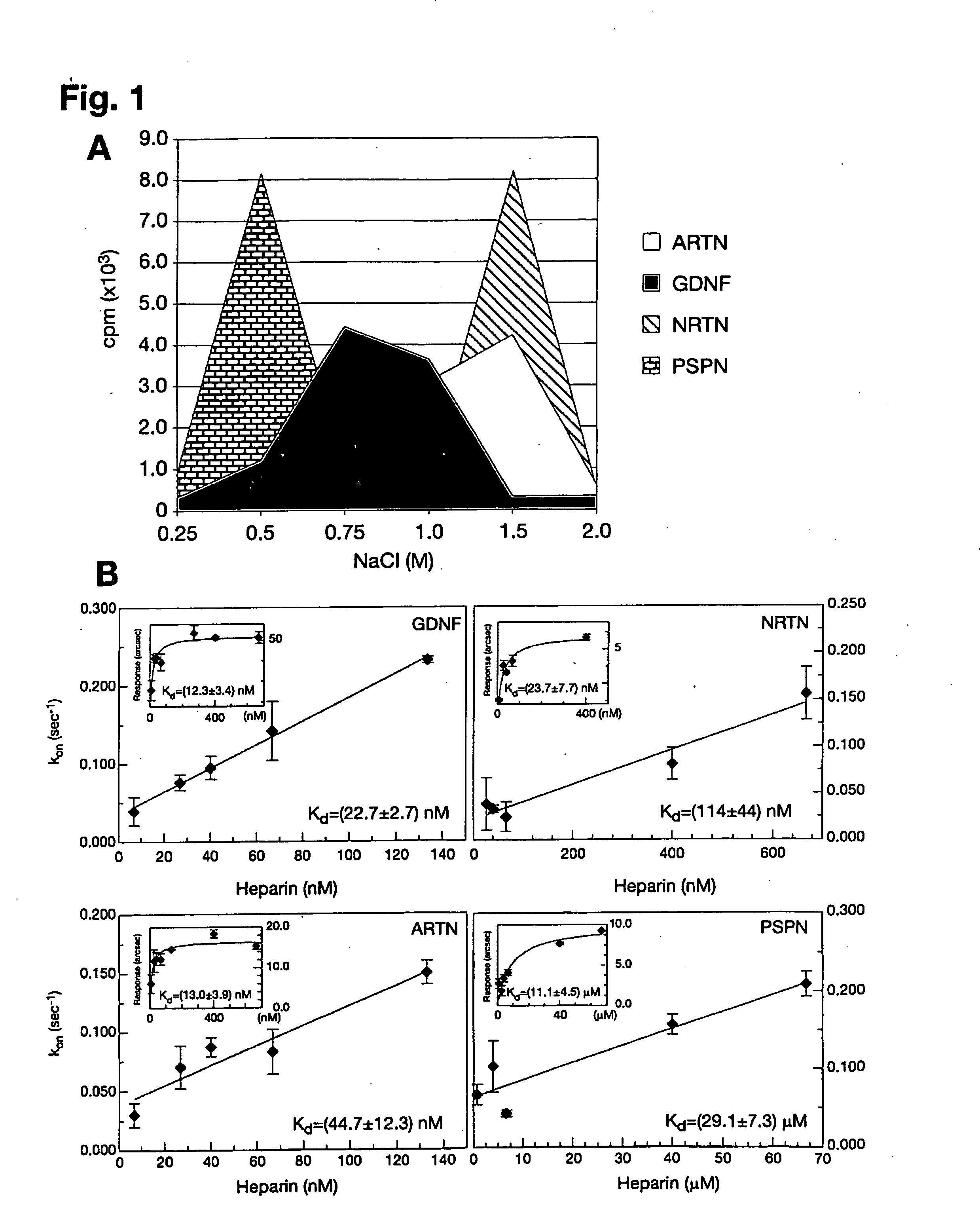Novel receptor for GDNF family ligands
a family ligand and receptor technology, applied in the field of new receptors for gdnf family ligands, can solve the problems that other studies have failed to show strong clinical benefits for gdnf, and achieve the effect of preventing or delaying a neurodegenerative process and better biodistribution of gfls
- Summary
- Abstract
- Description
- Claims
- Application Information
AI Technical Summary
Benefits of technology
Problems solved by technology
Method used
Image
Examples
example 1
Cell Cultures and Reagents
[0091]Rat glioma C6 cell line and mouse neuroblastoma cell line Neuro2a were from ATCC. Early passage RET-deficient human SHEP cells were provided by Dr. Marc Billaud (CNRS, Lyon, France). MG87-RET cells were provided by Dr. Carlos F. Ibáñez (Karolinska Institute, Stockholm, Sweden). Rat hippocampal neurons were isolated from E17 embryos. Mouse cortical neurons were isolated from E15 embryos. Low molecular weight heparin, heparin-BSA, EDACINHS crosslinker, lactoperoxidase, PI-PLC, chondroitinase ABC, globulin-free BSA and cell culture tested BSA were purchased from Sigma. SU6656 was bought from Calbiochem. Heparinase III was from Seikagaku Corp. (Seikagaku's trademark for this product is heparitinase I). The dominant-negative Src adenoviral construct was a kind gift of Dr. David Kaplan (Hospital of Sick Child, Toronto, Canada). Desulfated heparins were kindly provided by Dr. Ryo Takano (Okinawa National College of Technology, Nago, Okinawa, Japan).
example 2
GFL Iodination and Binding to Heparin-Sepharose
[0092]GFL iodination was performed as described (Lindahl et al., 2001). Heparin-sepharose column (Amersham Biosciences) chromatography was performed to assess GFL binding to heparin. GDNF, ARTN, NRTN and PSPN were purchased from PeproTech, Ltd. or R&D Systems, Inc. GFLs were enzymatically labeled with carrier-free [125I]NaI (Amersham Biosciences) by the lactoperoxidase method to a specific activity of 100000-200000 cpm / ng as described elsewhere (Lindahl et al., 2001). 15000-20000 cpm of iodinated GFLs, together with 10 μg of the same unlabeled protein as a carrier, were injected into a 1 ml heparin-sepharose column (Amersham Biosciences) in phosphate buffer pH 7.2 containing 100 mM NaCl and 10 mg / ml of BSA. After washing with 5 volumes of the same buffer, iodinated GFLs were eluted from the column by step elution (2 ml) with increasing NaCl concentration. The resulting fractions were counted on Rackbeta 1214 (LKB / Wallac) scintillation c...
example 3
Surface Plasmon Resonance (SPR) Studies
[0093]The affinities of GFLs for heparin and heparin-like molecules (e.g. syndecan-3) were determined by plasmon surface resonance using the IAsys system (Affinity Sensors, Cambridge, UK). Planar aminosilane cuvettes (Affinity Sensors) were used for protein coupling to avoid problems with mass transport, which occur frequently with matrix surfaces. In the initial approach, heparin-BSA was immobilized to the cuvette surface using the manufacturer's instructions and different ligand concentrations were used to determine association (ka) and dissociation (kdis) rates using the IAsys Fastfit software. The dissociation constant Kd was determined from the binding dynamics as Kd=ka / kdis, or from equilibrium response (R) using a simple Langmuir fit: R=(Rmax*C) / (Kd+C), where C is the ligand concentration. Because all ligands except PSPN displayed background binding to a control BSA cuvette, Kds were also determined in a system where GDNF, ARTN, NRTN and...
PUM
| Property | Measurement | Unit |
|---|---|---|
| Molar density | aaaaa | aaaaa |
| Molar density | aaaaa | aaaaa |
| Molar density | aaaaa | aaaaa |
Abstract
Description
Claims
Application Information
 Login to View More
Login to View More - R&D
- Intellectual Property
- Life Sciences
- Materials
- Tech Scout
- Unparalleled Data Quality
- Higher Quality Content
- 60% Fewer Hallucinations
Browse by: Latest US Patents, China's latest patents, Technical Efficacy Thesaurus, Application Domain, Technology Topic, Popular Technical Reports.
© 2025 PatSnap. All rights reserved.Legal|Privacy policy|Modern Slavery Act Transparency Statement|Sitemap|About US| Contact US: help@patsnap.com



